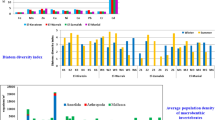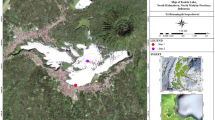Abstract
The taxonomic structure of diatom assemblages from the modern lacustrine sediments of the Kola Peninsula and Ni concentration in them are analyzed. It was found that the degree of negative transformation of structure of diatom assemblages from small (< 1 km2) and medium-sized (1–4 km2) lakes shows significant correlation with the Ni concentration in surface waters. A method of graphical analysis was applied to study the variations of taxonomic proportions in the diatom assemblages, which are proposed to use during integrated paleoecological investigations of bottom cores from weakly studied lakes of Caucasus. The prospects of application of the integrated analysis of bottom cores taken from lakes of different genesis are estimated. Obtained results have demonstrated that small closed lakes are the most promising objects for the assessment of heavy metal pollution caused by the transboundary transfer.
Similar content being viewed by others
References
R. W. Battarbee, “Diatom analysis,” in Handbook of Holocene Palaeoecology and Palaeohidrology (Wiley, Chichester, 1986), pp. 527–570.
D. B. Denisov, “Changes in the hydrochemical composition and diatomic flora of bottom sediments in the zone of influence of metal mining production (Kola Peninsula),” Water Res. 34(6), 682–692 (2007).
D. B. Denisov, L. Ya. Kagan, and V. A. Dauvalter, “Change of diatom complexes in the bottom sediments of Lake Bol’shoi Vudjavr (Kola Peninsula). Kola Peninsula on the turn of a third thousand,” in Ecological Problems, Ed. by N.A. Kashulin and O.I. Vandysh, (KNTs, RAN, Apatity), pp. 174–189.
R. E. Heskey, and P. Kilham, “Diatoms in alkaline saline lakes: ecology and geochemical implications,” Limnol., Oceanogr. 18(1), 53–71 (1973).
T. I. Moiseenko and N. A. Gashkina, Formation of Chemical Composition of Lake Waters under Environmental Change Conditions (Nauka, Moscow, 2010) [in Russian].
T. I. Moiseenko, V. A. Dauvalter, and L. Ya. Kagan, “Mountain lakes as indicators of air pollution,” Water Res. 24(5), 556–564 (1997)
T. I. Moiseenko, N. A. Gashkina, L. P. Kudryavtseva, S. S. Sandimirov, and Yu. A. Bylinyak, “Zonal features of the formation of water chemistry in small lakes in European Russia,” Water Res. 33(2), 144–162 (2006).
T. I. Moiseenko L. P. Kudryavtseva, and S. S. Sandimirov, “The principles and techniques for studying water quality under conditions of airborne anthropogenic pollution of watersheds: case study of the Kola subarctic region,” Water Res. 27(1), 81–89 (2000).
T. I. Moiseenko, L. V. Razumovskii, N. A. Gashkina, A. V. Shevchenko, V. L. Razumovskii, A. S. Mashukov, and V. Yu. Khoroshavin, “Paleoecological studies of mountain lakes,” Water Res. 39(5), 576–589 (2012).
A. Nesje, “A piston corer for lacustrine and marine sediments,” Arctic Alpine Res. 24(3), 257–259 (1992).
E. I. Polyakova, “Diatom Analysis,” in Methods of Paleogeographical Reconstructions (Mosk. Gos. Univ., Moscow, 2010), pp. 126–160 [in Russian].
L. V. Razumovskii and T. I. Moiseenko, “Estimation of spatiotemporal transformations of lake ecosystems by the method of diatom analysis,” Dokl. Biol. Sci. 429, 514–517 (2009).
L. V. Razumovskii and V. L. Razumovskii, “Registration of the youngest ecosystem, events in Lake Karakel from redeposited diatom assemblages,” Vestn. Tyumen. Gos. Univ. Ekol., No. 12, 121–127 (2013).
L. V. Razumovskii and T. S. Shelekhova, “The youngest history of the Bol’shoe and Zerkal’noe lakes from results of diatom analysis,” Vodn. Res. (in press).
L. V. Razumovskii, Assessing the Transformation of Lacustrine Ecosystems Using Diatom Analysis (Geos, Moscow, 2012) [in Russian].
L. V. Razumovskii, “Water quality estimation based on the structural analysis of diatomic complexes,” Water Res. 31(6), 689–697 (2004).
I. Renberg, “Paleolimnology and varve counts of the annually laminated sediment of Lake Rudetjärm, northern Sweden,” Early Norrland. 11, 63–92 (1978).
V. K. Shitikov, G. S. Rozenberg, and T. D. Zinchenko, Quantitative Hydroecology: Methods of System Identification (IEVB RAN, Tol’yatti, 2003) [in Russian].
O. N. Solomina, I. A. Kalugin, M. Yu. Aleksandrin, I. S. Bushueva, A. V. Darin, E. A. Dolgova, V. Zhomelli, M. N. Ivanov, V. V. Matskovskii, D. V. Ovchinnikov, I. O. Pavlova, L. V. Razumovskii, and A. A. Chepurnaya, “Drilling of sediments of Lake Karakel (Teberda River valley) and prospects of reconstruction of the Holocene glaciations and climate evolution in Caucasus,” Led Sneg 2(122), 102–111 (2013).
N. Solovieva, “A palaeoecological study of Holocene environmental change in a small upland lake from the Kola Peninsula, Russia,” Ph. D. Dissertation (Univ. College, London, 2000).
Author information
Authors and Affiliations
Corresponding author
Additional information
Original Russian Text © L.V. Razumovskii, V.L. Razumovskii, 2015, published in Geokhimiya, 2015, No. 3, pp. 289–296.
Rights and permissions
About this article
Cite this article
Razumovskii, L.V., Razumovskii, V.L. Assessing the heavy metal pollution by the study of diatom assemblages from lacustrine sediments, European Russia. Geochem. Int. 53, 277–284 (2015). https://doi.org/10.1134/S0016702915030118
Received:
Accepted:
Published:
Issue Date:
DOI: https://doi.org/10.1134/S0016702915030118




